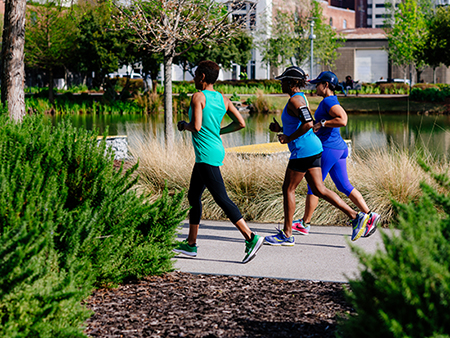
At the end of each holiday season, people set out to create new goals for the coming year as a new year presents a fresh start. Many health and exercise goals are created with the best of intentions but fall short in execution as people often overcommit those goals from the start, making them inevitably unattainable, unrealistic and easy to stop working toward.
“Most of the time, when people set health goals for the new year, they bite off more than they can chew,” said Eric Plaisance, Ph.D., chair of the University of Alabama at Birmingham Department of Human Studies. “My first recommendation to people who are setting exercise-related resolutions is to understand up-front the ‘why’ behind the goal: Why do you want to do this, what’s the purpose, what’s really driving you?”
Plaisance explains that, by understanding the reason behind a goal, a person can then figure out exactly what realistic measures look like and identify activities they could really enjoy doing — an aspect that is key for long-term success.
“Regardless of why a person approaches exercise, we want to make sure it’s something they enjoy and is something they can see themselves doing for a long time,” Plaisance explained. “Exercise is a lifelong process, and while setting resolutions gets people started, looking forward at what you want to accomplish will keep you engaged for the long haul.”
Plaisance shares his tried-and-true recommendations for setting and keeping resolutions intact.
Set small goals first: A common pitfall is setting a goal that you simply cannot reach yet. Plaisance encourages people to look at the big picture: If you want to start running, try running 1 mile. Once you can consistently meet that goal, set a new one — perhaps it is running 3 miles consecutively. As you build up those small goals, you can start looking toward achieving bigger ones.
“Every person has a starting point on what is comfortable, safe and realistic. Crossing off smaller goals makes you more motivated to keep chasing bigger ones as your body adapts.”
The scale is not a measure of success: Plaisance stresses that numbers on a scale are not indicative of progress but, rather, how a person looks and feels in their clothes. “Often people actually lose body fat but gain muscle when they are consistently exercising, so they see a literal larger number on the scale, but their clothes fit better than before — that’s the measure of progress that should motivate people.”
Reframe the time you have: The No. 1 reason people quit exercise altogether is that they feel that they do not have time, Plaisance shares. “They miss one workout and scrap the whole week, which then ultimately cancels out their goal.”
If you cannot get a full workout in, make modifications: Park a little farther away from the store’s entrance or take the stairs.
Another common reason for ditching resolutions is not being able to meet the length of a desired workout. The new mom who used to be able to take a 45-minute exercise class now has only 15 or 20 minutes to get it in. “That’s OK and plenty of time to get a good workout in,” Plaisance encouraged. “We actually have a tremendous amount of evidence to show that, if you can accumulate multiple bouts of exercise throughout the day, it can be even better than one single ‘longer’ workout. Take what you can get!”
Tailor health to your needs, no one else’s: Every person has different exercise needs and access; some people have at-home on-demand fitness platforms, other people are on a tight budget, and lot of people are not candidates for specific types of exercise.
“The key to developing sustainable resolutions is figuring out what works for you. If joining a gym right now is not in the cards, walking or running outside is perfect and free,” Plaisance said. “If you have health conditions that make high-intensity cardio a challenge, trying free low-impact exercises like yoga online could be a great fit for you. The beauty of exercise is that anything and everything can be tailored to fit what you and only you need.”
Before starting a new exercise regimen, Plaisance encourages asking your primary health care provider about what is considered a safe exercise plan for you.



